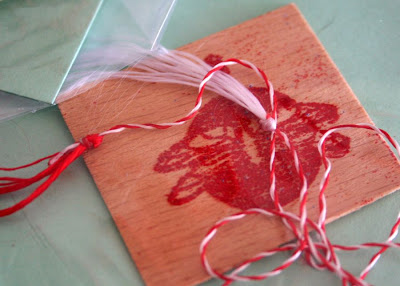March 1st brings the Spring: with warmth, the colourful and fragrant flowers, the chirping birds and with lots of happiness. Martisorul (pronounced something like Martzishor, and meaning 'little March' or 'dear March') is a pre-Christian custom - linked to the agricultural practices and beliefs (the 3 countries have been predominantly agricultural for almost all their history; industrializing them is a 'modern' idea, brought by socialism and communism). This is an incredible old custom: on the Romanian territory archaeologists have found Martisoare over 8,000 years old (yes, you read correctly: 8 thousand years).
There are many legends around this custom - you can read about one of them in a previous article here.
This is an incredible old custom: on the Romanian territory archaeologists have found Martisoare over 8,000 years old (yes, you read correctly: 8 thousand years). The little talismans come in many forms - usually as flowers, animals, or symbols of luck (the 4 leaf clover, chimney sweepers, or horseshoes) - but they all have one thing in common: a red and a white thread, twisted together in one balanced thread. The 2 colours are a symbol of death (red) and new life (white), winter / spring, darkness / light: the perfect balance and continuous cycle of nature.
The little talisman is offered to the loved ones: especially children and women (there are regions where young men will be offered a Martzishor as well) and it is worn for 2 weeks (sometimes more). There are as many traditions as regions: in some places the Martzishor was a coin strung on the red & white thread; the girls would wear it for 12 days, then the thread was set on a branch, and with the coin they would buy themselves a piece of cheese, so their face will be white and beautiful for the whole year. In other regions - after the 12 days, the Martzishor was set in the gates, windows, wells, even the animals' horns: to repel the bad spirits and to invoke life and its power.
No matter the region - this is a beautiful custom, one I am trying (hard) to keep. Every year I make Martzishoare with William - to share at school. The children are happy to hear about other traditions, and they are enchanted with the little charms.
The 'lot' from last year can be seen here: Martzishor 2012
This year I almost forgot to take a picture of the charms we made... but here you are:
.JPG) |
| William's set of Martzishor for this year |
 |
| The boy's version: a dragonfly |
 |
| The girl's version: a butterfly |
What special traditions or customs do you observe in your family?

What a wonderful tradition, Alicia... I say anything that breaks up winter's hold and makes us anticipate spring, we should grab! I love that you are sharing at William's school, 'cause that is where real acceptance of unfamiliar culture takes place, among the youth.
ReplyDeleteVery cool! Can't wait to see how you use my charms!
ReplyDeleteDonna XOX
I just love hearing about the history and customs of Romania. Thanks for sharing! This a really interesting one
ReplyDeleteWhat a longstanding and hopeful tradition. I was going to write something similar to what Monique said about William sharing this at school :-)
ReplyDeleteWhat a wonderful tradition. I will really look further into this on as spring is my favorite time of the year. Thank you for sharing.
ReplyDeleteThank you for sharing your heritage with us. It does seem that many older customs have been incorporated in the modern New Year now and you're right, it doesn't always make sense to celebrate this in January.
ReplyDeleteLove how you teach us of the multicultural world we share! So cool that you & your dear son create Martisoare to honor Martzishor -- keeping the tradition of talismans 8,000 years old is awesome!
ReplyDeleteYour post, your Martisoare, and your charms are all awesome! I thank you :) And I am enjoying very much my new thinking of March as the beginning of a new year -- it really has felt like a new time to me, since my children were little, and now I have an understanding of why.
Bravo! Gracias!
Hi Alicia,
ReplyDeleteThank you for sharing another old country tradition, that you are keeping alive. I enjoy reading about the old traditions from your Mother country Romania. Spring is a welcoming season in many cultures, it is a shame that these traditions are not as celebrated in our modern times.
Therese